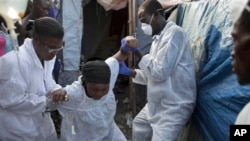Scientists studying temperature and rainfall patterns in areas that later had cholera outbreaks say small increases in warmth and wetness are followed by a surge in cholera cases a few months later. The information could give public health authorities a new tool to help battle this serious disease.
According to the World Health Organization, more than 100,000 people die from cholera each year, despite a vaccine which can prevent infection and simple treatment that works most of the time.
Advance notice of an outbreak might help in the battle against the acute diarrheal disease.
Now, an international team working in Tanzania has found that rising temperature and increased rainfall can signal a coming surge in cholera cases.
"What these authors from the International Vaccine Institute in [South] Korea, as well as the University of North Carolina, and the Ministry of Health in Zanzibar in Tanzania have shown," says cholera expert Peter Hotez, "is that a one degree increase in temperature can ultimately result in a two-fold increase in the number of cholera cases."
Hotez is president of the American Society of Tropical Medicine and Hygiene, which published the research in its journal.
He says that previous research had established that the Vibrio cholerae bacteria can thrive in the gut of a tiny aquatic animal called a copepod.
"So the rationale for looking at temperature is because we know that increases in temperature can result in proliferation of these copepods and therefore create new niches for the Vibrio cholerae to replicate."
Cholera is typically spread through contaminated water, and with the bacteria proliferating when temperatures and rainfall increase, the number of infections also increases. As global temperatures have risen in the past decade, so have the number of cholera cases, according to the WHO. And Hotez says the nature of the outbreaks is changing, too.
"Now we're seeing long and very protracted outbreaks of cholera, like the one that's been occurring in Haiti and now the Dominican Republic. For instance, the epidemic in Zimbabwe lasted a year and caused 4,000 deaths, and we're probably seeing something of similar magnitude in Haiti."
Lead author Rita Reyburn and colleagues point out that climate scientists are predicting a rise in global mean temperatures over the next century of between one and six degrees Celsius. The authors say that suggests the "possibility of increased cholera incidence in many resource-poor regions of the world."
Scientists Find Temperature, Rainfall Can Predict Cholera
- By Art Chimes

Slight rise in temperature can double number of cases










